Alienware M17x R4 Notebook Review: Ivy Bridge and the GeForce GTX 680M
by Dustin Sklavos on September 21, 2012 12:01 AM ESTDisplay Quality
Given that the Alienware M17x R4 review unit we have on hand sports the exact same panel as last year's model, there shouldn't be any surprises here. The M17x R4's display is a pretty good one, and we definitely recommend spending the $150 for the upgrade to this 1080p panel (the default is a 1600x900 panel--too low-resolution for a 17.3" display in our book).
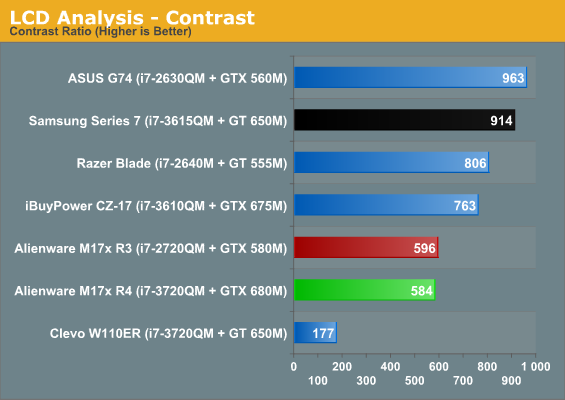
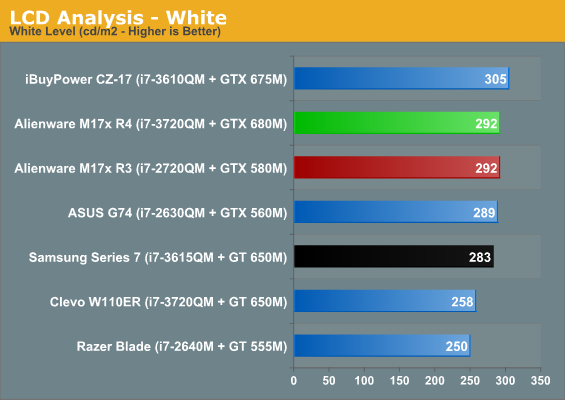
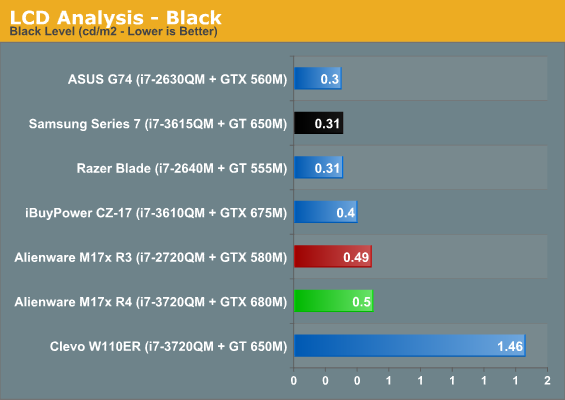
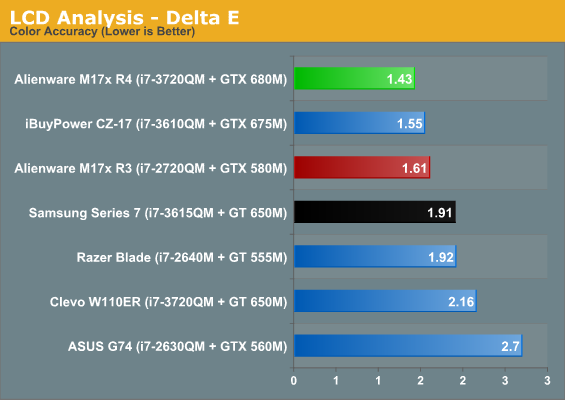
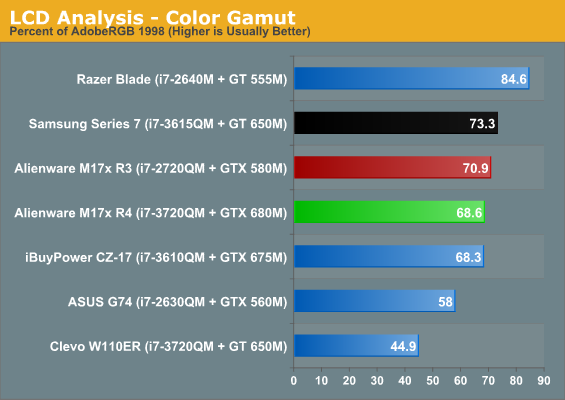
As it turns out, virtually nothing has changed. If you were happy with the M17x R3's display, you'll continue to be happy with the M17x R4's. If you want a high gamut panel, IPS, or a matter surface, however, you're out of luck.
Build Quality
So unfortunately, here's where things kind of take a turn with the Alienware M17x R4. When I reviewed the M17x R3, I was in the market for a new 17" desktop replacement notebook and virtually nothing I'd seen had really excited me. Clevo's notebooks still had their candy shells and dire keyboards, and even ASUS' notebooks featured somewhat underpowered graphics hardware at the time. Yet the M17x R3 had an attractive screen, a fairly comfortable keyboard and touchpad, and performance to spare.
The problem is that in the intervening year, times have changed, and companies should be willing to iterate on their products and continue to develop them. The M17x R4 gains a couple USB 3.0 ports and an mSATA port, and that's about it outside of the expected generational internal hardware improvements. In the meantime, Clevo fixed their keyboards [ed: well, at least they tried to--we'll have more to say on this very soon], ASUS has faster graphics hardware in their gaming notebooks (and enjoys Optimus), and even MSI and iBuyPower's Valkyrie CZ-17 scored a surprise win by including one of the most comfortable keyboards I've yet tested on a notebook.
.jpg)
Unfortunately, familiarity with the M17x R3/R4's design has lead to some notable issues. The edge-to-edge glossy display photographs well and captures that initial "ooh shiny" reaction, but in practical use becomes frustrating in short order. The gloss is too reflective, and on dark images it can be incredibly distracting. It also picks up dirt and fingerprints with tremendous ease.
Meanwhile, though the keyboard's feedback is generally good and the touchpad's texture is quite comfortable, the sharp angles of the front edge of the notebook can very easily dig into your wrists over an extended period of use. On a notebook and keyboard this size, an inclined typing surface would do wonders (part of what makes competing designs more comfortable to use). The M17x's flat surface and hard angles actually make it uncomfortable to use.
I do like the bling of the Alienware notebook line, however; there really is something very enjoyable and satisfying about being able to customize the backlighting, and I'm the only person I know that has a notebook that glows fuschia. The keyboard layout itself also remains unimpeachable. But this design needs to be improved, a notion that I'll reiterate when I get to noise and heat.


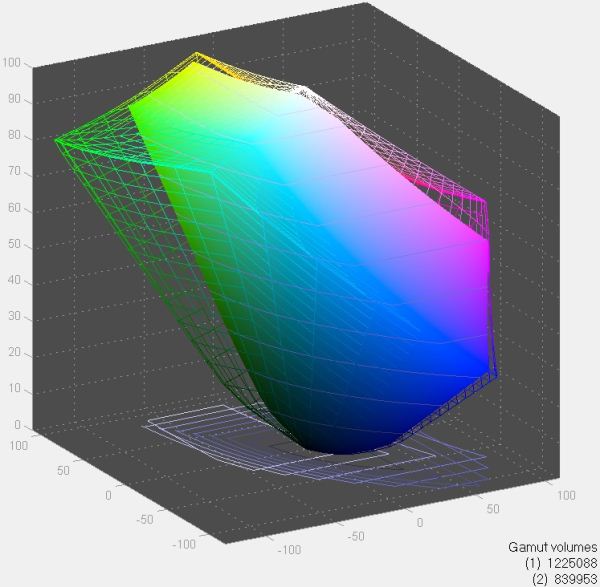
_thumb.jpg)
_thumb.jpg)
_thumb.jpg)
_thumb.jpg)
_thumb.jpg)
_thumb.jpg)








61 Comments
View All Comments
PubFiction - Friday, September 21, 2012 - link
I used a new clevo keyboard and it was horrible compared to the alienware. I cannot imagine how bad it was before.JarredWalton - Friday, September 21, 2012 - link
It looks better in images... Dustin hasn't actually used it in person I don't think, and I can attest that the new keyboards actually feel worse than the old ones (and continue to have wonky layout issues). They fixed the number keypad but screwed up the Windows key, took out the context key, and put two backslash keys on the keyboard. I understand Clevo targets an international community, but they should just have a few separate hardware layouts for different regions rather than reusing the same layout and relabeling keys.jbordon - Friday, September 21, 2012 - link
This might not be the place, but since it's a review of a gaming laptop, I'm wondering what's up with Razer Blade r2 review?Need more looks versus power debates!
QChronoD - Friday, September 21, 2012 - link
Either I'm confused or there is an error in those graphs. The Samsung Series 7 and the Clevo W110ER both have 62Wh (according to the charts) and the Samsung beats it in all the tests. Yet when you normalized min/Wh the Clevo appears to be more efficient.drfish - Friday, September 21, 2012 - link
The numbers for the Clevo battery life are wrong anyway - no one is getting that much use out of their systems on battery. They should be looked at again or not included in future benchmarks.JarredWalton - Friday, September 21, 2012 - link
The Samsung has a 77Wh battery; I've updated the charts for Dustin. As for the W110ER, I'm still not sure how Vivek got those numbers, so you'll have to ask him. Unfortunately, he no longer has the Eurocom Monster 1.0 -- I wonder if Eurocom actually managed to fix the battery life somehow and other Clevo W110ER units are still getting crappy power optimizations? I tested a W110ER from another company and got half the battery life; they ended up asking for the unit back to "look into the problem" and never sent another, so I assume there's a core issue that Clevo isn't fixing.drfish - Friday, September 21, 2012 - link
Thanks for always replying to my posts about the W110ER's battery life. :)I have no idea how many of them have been sold but I have to consider it "popular" for a niche device so if anyone at Anandtech wanted to look into it deeper I think there would be an audience eager to read their results. Maybe even see how a BIOS mod changes things (http://biosmods.wordpress.com/w110er/).
JarredWalton - Friday, September 21, 2012 - link
Sadly, as you can imagine no one is really interested in sending us an "older" laptop like the W110ER, especially if all we're going to do is double-check the battery life (and probably end up disappointed). For the record, my test results from a system we ended up sending back before completing the review show the following with a 3610QM CPU:Idle: 217 minutes
Internet: 209 minutes
H.264: 187 minutes
That last item tells you just how bad the battery life is (was?) optimized on that particular unit, as H.264 battery life is typically 2/3 of the Internet battery life, which in turn is about 80% of the Idle battery life. Based off of the "estimates", assuming the H.264 result is a good starting point, the W110ER should be getting 280 minutes Internet and 350 minutes Idle, and of course the H.264 result is already low to begin with.
Vivek's numbers on the Monster 1.0 actually seem perfectly legit (407, 338, 218 means Internet is 55% better than H.264 and Idle is 20% better than Internet). So the question is, how did Eurocom get such good results when no other W110ER seems to? Clevo is often pretty lousy at power management, and the P170EM and P150EM are right in that same categorization. They should be paying Eurocom for whatever fix is present in the Monster.
drfish - Friday, September 21, 2012 - link
I would gladly pay Eurocom for that "fix" *sigh*Thanks for the additional details!
Drasca - Saturday, September 22, 2012 - link
I've got a Eurocom Monster 1.0 My battery life is in between Jarred's and Vivek's.Last I checked, I can watch two 2 hr movies on VLC before it gets "low".
I'll can run a few battery life tests, but I do not have the exact anandtech suite or standardization. I'd appreciate any suggestions on what should be setup.
Specs:
CPU: 3820QM
Display: AUO Matte Screen
GPU: Nvidia 650m 2 Gb
RAM: 8 Gb
Storage: Intel 520 256 Gb
Wifi card: Intel 3000